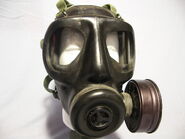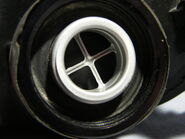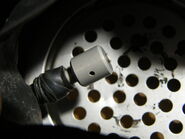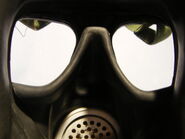m (moved headings) Tag: Visual edit |
No edit summary |
||
| Line 1: | Line 1: | ||
{{Mask |
{{Mask |
||
|name = S6 |
|name = S6 |
||
| − | |image = File: |
+ | |image = File:DSCF0112.JPG |
|previous = [[MK II Light Anti-gas Respirator]] |
|previous = [[MK II Light Anti-gas Respirator]] |
||
|next = [[S10]] |
|next = [[S10]] |
||
Revision as of 10:11, 10 February 2019
The S6 respirator was developed in the 1950s by the Defence Science and Technology Laboratory, Porton Down and was manufactured by the Birmingham & Leyland Rubber Company. The S6 gained notoriety when seen being used by Britain’s Special Air Service (SAS) during the widely and thoroughly documented Iranian Embassy Siege on 5 May, 1980.
Design
The features of the S6 include the very innovative inflatable air seal around the inside of the face piece.It also had an early design of an oral-nasal cup that was built into the mold of the mask, not a separate piece extending from the interior of the face piece to cover the nose and mouth. It features a six point semi-elastic head harness with easily adjustable metal buckles.
The mask provides an excellent field of vision using larger eyepieces in the shape of half rounded rectangles.
Additionally, the S6 is made of a soft black rubber. The mask uses a side loading filter to the left of the mask, making it much easier and more natural to shoulder a firearm for right-handed soldiers. A version of the mask was made to accommodate left-handed shooters, where the filter input was simply switched to the right side. It was very much liked by the British military for its comfort and very low breathing resistance.
Gallery
Variants
In the early 80s, the armed forces of Turkey adopted the S6 as the SR10, and subsequently added a drinking tube to the design, designating their version of this mask as the SR-10ST.




